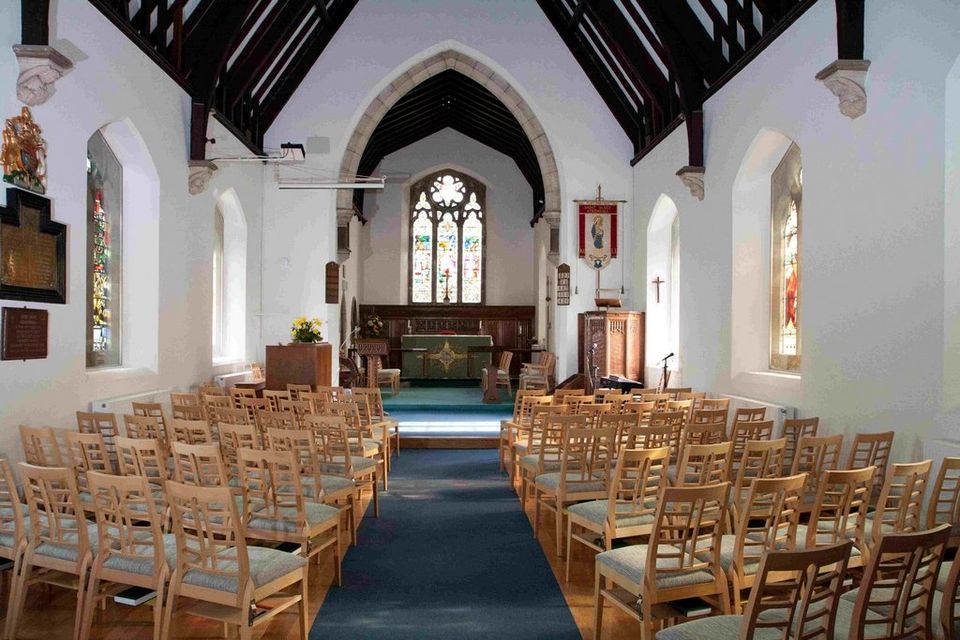A list of all of the Vicars of Strensall can be found at below. If you are interested in local history you might be interested in the visiting the
Strensall Local History Group webpage.The village of Strensall existed before the Norman Conquest. The land at Strensall, formerly Streonaeshalch, (Streona is an ancient personal name and Halch is an Anglo-Saxon word meaning nook or plot of land) was passed into the ownership of the Church before the Norman Conquest. The Doomsday Book of 1086 lists it in the Estates of the Archbishop of York and also as a
Prebend
of St Peter's Church, York. However in the Doomsday Survey of 1086 there is no mention of a church. This probably means that the earliest church in Strensall was that described by the Rev John Hodgkinson, Vicar of Strensall 1843 - 1884. He wrote:
"The Parish church was originally a Norman structure, the walls being rubble with door and window jambs and coigns of dressed Tadcaster or Bramham Moor stone. The interior fittings were rude and massive; the seats open, of thick rough-hewn oak. The date of its erection is not known but from fragments still existing is supposed to have been between 1100 and 1150".
This first church was in a state of decay when, in 1801, a faculty was granted for extensive rebuilding on the original foundations. This work was carried out in 1803 - 1804. The Rev John Hodgkinson wrote:
"A new
chancel
was built by the Rev. John Ellis the then Lord of the Manor and a new
nave
and chancel by the Parishioners, all of brick (made for the purpose on Strensall Common End) but entirely wanting in architectural or Ecclesiastical style, with walls only 14 inches thick. The interior was fitted with square pews of painted deal and of inconvenient form. There was an unsightly gallery at the West End. The windows were ordinary deal sashes, painted, having large squares. The Tower was square at the bottom and octagonal at the top and contained two bells".
The parishioners rated themselves for a number of years at 2 shillings in the pound to pay for the nave. A man living in the 1850s records that a small choir and an assortment of musicians, playing on bass fiddle, clarinet, small fiddles and flute used the gallery. The box pews were overlooked by the
Parson
mounted in a high
pulpit
and the
Sexton
at a high reading desk. By 1863 this church was in a very dilapidated condition and when autumn gales caused much damage to the fabric it was decided to replace it with a completely new building. The sum needed to build and furnish the present church; £1,523.12s.6d, was raised almost entirely by subscription, thanks largely to the tireless efforts of the vicar, John Hodgkinson, who has left detailed accounts. Leonard Thompson Esq., of Sheriff Hutton Park, Lord of the Manor of Strensall, paid for the
chancel.In May 1865 the foundation stone was laid by his wife, Lady Mary Thompson and the building was consecrated by the Archbishop of York, William Thompson, on 25th July (the Festival of St. James) 1866. The architects were Messrs. J. B. and W. Atkinson of York and the church is built in the Early Decorated style to a design said to be that of Sir Gilbert Scott. The building consists of an aisle-less nave and a chancel with a south porch and a western tower, which houses six bells. One of the bells is a recasting of a medieval bell removed from the previous bell tower and which bore the inscription:
Jacobi in honore saunti Walterus me fecit (In honour of St. James Walter made me).
There is indeed evidence that the original church was dedicated to St. James, hence the inscription on the original bell. In 1428
Indulgences
were granted to
penitents
who visited the church of St. James at Strensall and gave
alms
for its repair, and in 1451 the vicar of St. James of Strensall was paid 6s. 8d. to pray for the soul of Thomas Vicars.
During the 20th century the church has been maintained with loving care, sundry changes being made in the interior and much of the work being carried out by local craftsmen. A new
vestry
was added on the north side in 1961. The stonework has been repaired recently and the church was re-floored in 1976. In 2009 the boiler had to be replaced after failing completely. The work revealed the need to replace the rest of the heating system, including pipework that dated from the Victorian era. Unfortunately this required the nave floor to be completely lifted. When re-instated, the floor had to be level to meet current regulations and it was not possible to reinstate the pews. The floor was re-laid with polished oak blocks and the pews were replaced with high-quality bespoke chairs. Further changes included the creation of a '
Lady Chapel' on the north side of the Chancel, where the Vicar's Vestry used to be. A new wall with an integrated seat and
altar
was constructed in the chapel. The doorway leading into the nave was removed and the wall re-instated and a completely new window looking into the Chancel was constructed. A new access door and steps from the outside was installed. The Vicar's Vestry was moved to a new location under the bell-tower.













